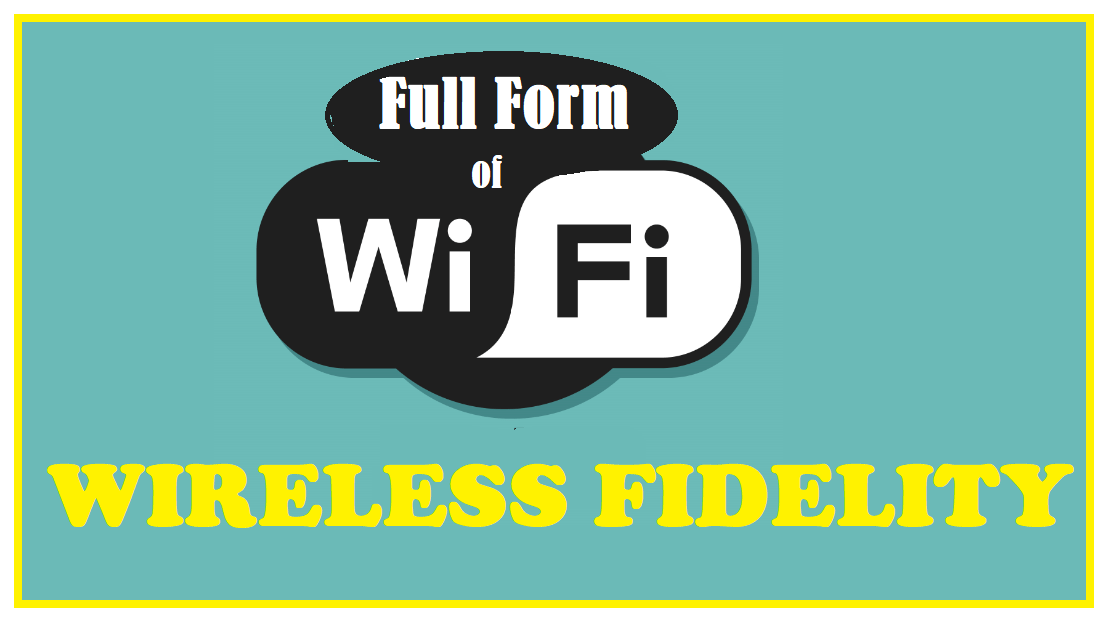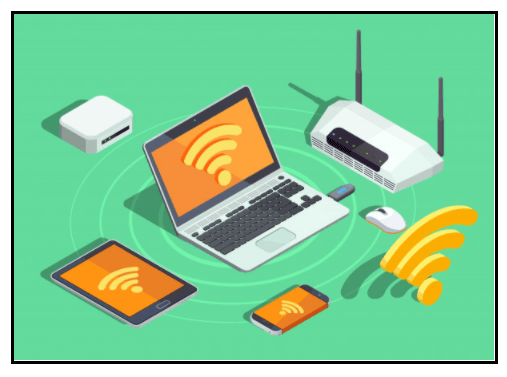Full Form of Wi-Fi
Full Form of Wi-Fi
Our world is more digitally connected than ever before, and emerging technologies are ensuring to amplify this connection. Devices like mobile phones, smartwatches, speakers, tablets and laptops are connected to Wi-Fi networks to give instantaneous access to information and entertainment. But do you know what does Wi-Fi stands for?
The full form of the abbreviation W-Fi is Wireless Fidelity.

This tutorial will briefly learn about the definition, its application, working structure, objective, technical specifications and other detailed information about Wireless Fidelity or Wi-Fi.
What is Wi-Fi?
“Wi-Fi or Wireless Fidelity is Wireless Local Area Network (WLAN) used to support digital gadgets and employ ISM radio frequencies to migrate data or connect the electronic devices to the Internet.”
Wi-Fi is a miraculous technology that provides the power to send and receive huge amounts of data seamlessly through the air. Wi-Fi enables systems to establish a connection with electronic devices over a wireless network. Wi-Fi’s devices and components are based on the IEEE (Institution of Electrical and Electronics Engineers) 802.11 family of standards and are owned by the Wi-Fi alliance. To connect to a Wi-Fi network, a user should select the network name (the SSID) and type the password (if it is locked with a password). Almost all Wi-Fi networks are encrypted with passwords to prevent unauthorized access. Wi-Fi networks are constructed with the help of hardware devices like routers and end-user devices (smartphones, smartwatches, laptops, tablets) equipped with Wi-Fi adapter.
With time and digitalization, Wi-Fi has gained huge popularity, and the world has witnessed a massive increase in internet traffic. From 1995 to the end of 2020, there is a rapid growth of internet users, i.e., from 16 million to more than 696.77 million users worldwide, only because of wireless networks' advancement.

The overviews of Wi-Fi are as follows:
| Overview | Wifi |
| Introduced at | 21 September 1998 |
| Associated hardware’s | Personal computers, gaming consoles, Modern Televisions, watches, Speakers, Phones, Digital Cameras, , printers, other modern electronic devices |
| Types | DipoleFractalLoopMonopoleSatellite dishTelevisionWhip |
| Components Used | BalunRotatorBlock upconverterReceiverCoaxial cableFeedLow-noise block downconverterCounterpoise Passive radiatorTwin-leadStubTransmitterTuner |
How does Wi-Fi work?

For Wi-Fi to work, a wireless router is connected to the internet via fiber cable or an analog line that uses a telephone line or modem. The modem is further connected to the wireless router. The modem (Modulator or Demodulator) is responsible for converting an analog signal to digital and vice-versa. The Wi-Fi router connects several end-devices with radio waves and establishes an end-to-end internet connection. A seamless Wi-Fi connection is created through the technology known as signal processing. For Wi-Fi to work actively, signal processing has to fulfill two main tasks:
1. Concluding those devices which can be active at all times
2. Encoding the information bits transmitted over the air
A household typically has only one form of internet connection (DSL, cable or fiber optics). But to that Wi-Fi, multiple gadgets are connected. Suppose you are working on your laptop and also scrolling on YouTube on your smartphone. These devices access the required information by sending signals to the same router to access information. But there are chances that the transmitted signals from the device may collide with each other, and to avoid this collision, CSMA (Carrier sense multiple access) is used. CSMA decides whether a channel is available for it to use or not by absorbing the radio spectrum. When a Wi-Fi gadget utilizes a channel, it specifies how long it wants a Channel, allowing other Wi-Fi devices to conclude when the channel will be free. So while someone might stream video on their laptop and use their smartphone at the same time, it's the unseen rapid transfer of channel access in the airwaves that allows the use of both devices simultaneously and without interruption.
In an ideal situation, there is only one direct path between the device and the router. But that is not valid as signals can also be deflected because of the surrounding environments like walls, floors, and other household items. Thus, it creates multipath channels, which results in the entanglement of signals in the time domain. Signal processing engineers overcome this by using a technology called Orthogonal Frequency Division Multiplexing or OFDM. This technology utilizes the concepts of time and frequency in signal processing. It uses an algorithm that efficiently converts signals from the time domain to the frequency domain and vice-versa.
Applications of Wi-Fi
Wi-Fi has become the prime requirement almost in all offices and households. It is widely used to exchange data and access entertainment over radio signals. Though Wi-Fi is not limited to this, it has several other applications in this technological era. A few of them are listed below:
- Wi-Fi helps to access the internet on your electronic devices
- Enables you to stream audio wirelessly on your smart speakers
- It helps you connect your smartwatches to your phone and allows you to access the information.
- It facilitates the remote access of digital cameras
- Sending files to the printer digitally
- Wi-Fi allows mirroring or remote screen sharing
Characteristics of Wi-Fi
The various Characteristics of Wi-Fi are as follows:
- Wi-Fi is created on the technology where it works over a wireless network.
- Wi-Fi network is created with the help of radio waves.
- It supports broadcast frequencies of 2.4 GHz and 5 GHz.
- To establish a Wi-Fi network, the users need the help of routers or hotspots.
- Easy to connect and do not require any use of wires or cables.
- Wi-Fi network services are not expensive and require only a few resources (as compared to wired internet connection).
Disadvantages of Wi-Fi
Although wireless fidelity, aka Wi-Fi, is a flexible technology for connecting multiple devices with the internet, it has some shortcomings as well which are as follows:
- Wi-Fi is a less secured internet connection in terms of data privacy than a wired connection because people can track your activities in wireless networks.
- Users can experience retardation in speed if multiple devices get connected to the router.
- Wi-Fi network has a limited range.
Wi-Fi: Technical Specifications
Following are the most popular Wi-Fi standards:
| 802.11a | Speed up to 54 Mbps on 5 GHz bandwidth |
| 802.11b | It is also known a Wi-Fi1, and it offers an indoor range of 120 feet. |
| 802.11g | This standard provides Speed up to 54 Mbps and can reach up to 300 feet in outdoor range |
| 802.11n | This standard can provide up to 300 Mbps of speed and features 2.4 GHz bandwidth and 5 GHz bandwidth |
| 802.11ac | It is the fastest of all the standards. It is capable of providing a speed up to 866.7 Mbps on 5 GHz bandwidth. |